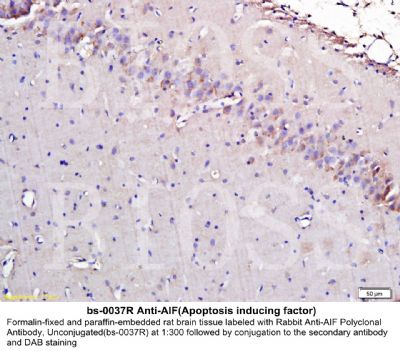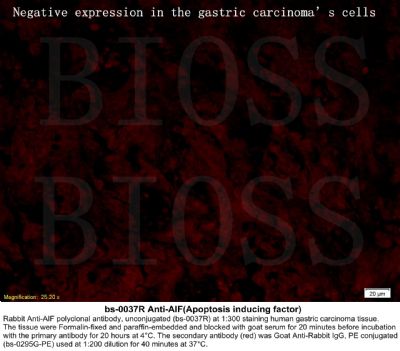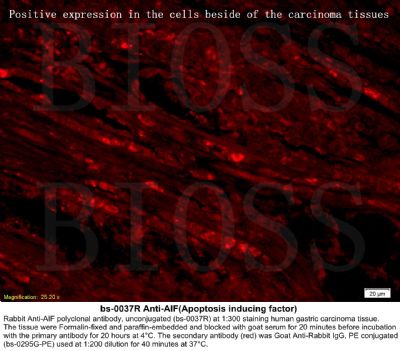产品中心
当前位置:首页>产品中心Anti-AIF
货号: bs-0037R 基本售价: 380.0 元 规格: 20ul
- 规格:20ul
- 价格:380.00元
- 规格:50ul
- 价格:780.00元
- 规格:100ul
- 价格:1380.00元
- 规格:200ul
- 价格:2200.00元
产品信息
- 产品编号
- bs-0037R
- 英文名称
- AIF
- 中文名称
- 调亡诱导因子抗体
- 别 名
- Apoptosis inducing factor; Harlequin; Hq; mAIF; MGC111425; MGC5706; PDCD 8; PDCD8; Programmed cell death 8; Programmed cell death 8 isoform 1; Programmed cell death 8 isoform 2; Programmed cell death 8 isoform 3; Programmed cell death protein 8 mitochondrial; Programmed cell death protein 8 mitochondrial precursor; Striatal apoptosis inducing factor; AIFM1_HUMAN; Apoptosis-inducing factor 1, mitochondrial.

- Specific References (2) | bs-0037R has been referenced in 2 publications.[IF=5.40] Gong, Ping, et al. "Hypothermia-induced neuroprotection is associated with reduced mitochondrial membrane permeability in a swine model of cardiac arrest." Journal of Cerebral Blood Flow & Metabolism (2013). WB ; Pig.PubMed:23486294[IF=3.26] Li, Zhiping, et al. "Anti-Oxidative Stress Activity Is Essential for Amanita caesarea Mediated Neuroprotection on Glutamate-Induced Apoptotic HT22 Cells and an Alzheimer’s Disease Mouse Model." International Journal of Molecular Sciences 18.8 (2017): 1623. WB ; Mouse.PubMed:28749416
- 规格价格
- 50ul/780元购买 100ul/1380元购买 200ul/2200元购买 大包装/询价
- 说 明 书
- 50ul 100ul 200ul
- 研究领域
- 肿瘤 细胞生物 染色质和核信号 神经生物学 细胞凋亡 细胞周期蛋白 线粒体
- 抗体来源
- Rabbit
- 克隆类型
- Polyclonal
- 交叉反应
- Human, Mouse, Rat, Chicken, Dog, Pig, Cow, Rabbit, Sheep,
- 产品应用
- WB=1:500-2000 ELISA=1:500-1000 IHC-P=1:400-800 IHC-F=1:400-800 ICC=1:100-500 IF=1:100-500 (石蜡切片需做抗原修复)
not yet tested in other applications.
optimal dilutions/concentrations should be determined by the end user.
- 分 子 量
- 57kDa
- 细胞定位
- 细胞核 细胞浆 线粒体
- 性 状
- Lyophilized or Liquid
- 浓 度
- 1mg/ml
- 免 疫 原
- KLH conjugated synthetic peptide derived from human AIF:131-230/613
- 亚 型
- IgG
- 纯化方法
- affinity purified by Protein A
- 储 存 液
- 0.01M TBS(pH7.4) with 1% BSA, 0.03% Proclin300 and 50% Glycerol.
- 保存条件
- Store at -20 °C for one year. Avoid repeated freeze/thaw cycles. The lyophilized antibody is stable at room temperature for at least one month and for greater than a year when kept at -20°C. When reconstituted in sterile pH 7.4 0.01M PBS or diluent of antibody the antibody is stable for at least two weeks at 2-4 °C.
- PubMed
- PubMed
- 产品介绍
- background:
This gene encodes a flavoprotein essential for nuclear disassembly in apoptotic cells, and it is found in the mitochondrial intermembrane space in healthy cells. Induction of apoptosis results in the translocation of this protein to the nucleus where it affects chromosome condensation and fragmentation. In addition, this gene product induces mitochondria to release the apoptogenic proteins cytochrome c and caspase-9. Mutations in this gene cause combined oxidative phosphorylation deficiency 6, which results in a severe mitochondrial encephalomyopathy. Alternative splicing results in multiple transcript variants. A related pseudogene has been identified on chromosome 10. [provided by RefSeq, May 2010].
Function:
Probable oxidoreductase that has a dual role in controlling cellular life and death; during apoptosis, it is translocated from the mitochondria to the nucleus to function as a proapoptotic factor in a caspase-independent pathway, while in normal mitochondria, it functions as an antiapoptotic factor via its oxidoreductase activity. The soluble form (AIFsol) found in the nucleus induces parthanatos i.e. caspase-independent fragmentation of chromosomal DNA. Interacts with EIF3G,and thereby inhibits the EIF3 machinery and protein synthesis, and activates casapse-7 to amplify apoptosis. Plays a critical role in caspase-independent, pyknotic cell death in hydrogen peroxide-exposed cells. Binds to DNA in a sequence-independent manner.
Subunit:
Interacts with XIAP/BIRC4. Interacts (via N-terminus) with EIF3G (via C-terminus).
Subcellular Location:
Mitochondrion intermembrane space. Mitochondrion inner membrane. Cytoplasm. Nucleus. Cytoplasm, perinuclear region. Note=Proteolytic cleavage during or just after translocation into the mitochondrial intermembrane space (IMS) results in the formation of an inner-membrane-anchored mature form (AIFmit). During apoptosis, further proteolytic processing leads to a mature form, which is confined to the mitochondrial IMS in a soluble form (AIFsol). AIFsol is released to the cytoplasm in response to specific death signals, and translocated to the nucleus, where it induces nuclear apoptosis. Colocalizes with EIF3G in the nucleus and perinuclear region.
Tissue Specificity:
Isoform 5 is frequently down-regulated in human cancers.
Post-translational modifications:
Under normal conditions, a 54-residue N-terminal segment is first proteolytically removed during or just after translocation into the mitochondrial intermembrane space (IMS) by the mitochondrial processing peptidase (MPP) to form the inner-membrane-anchored mature form (AIFmit). During apoptosis, it is further proteolytically processed at amino-acid position 101 leading to the generation of the mature form, which is confined to the mitochondrial IMS in a soluble form (AIFsol). AIFsol is released to the cytoplasm in response to specific death signals, and translocated to the nucleus, where it induces nuclear apoptosis in a caspase-independent manner.
Ubiquitination by XIAP/BIRC4 does not lead to proteasomal degradation. Ubiquitination at Lys-255 by XIAP/BIRC4 blocks its ability to bind DNA and induce chromatin degradation, thereby inhibiting its ability to induce cell death.
DISEASE:
Combined oxidative phosphorylation deficiency 6 (COXPD6) [MIM:300816]: A mitochondrial disease resulting in a neurodegenerative disorder characterized by psychomotor delay, hypotonia, areflexia, muscle weakness and wasting. Some patients manifest prenatal ventriculomegaly and severe postnatal encephalomyopathy. Note=The disease is caused by mutations affecting the gene represented in this entry.
Similarity:
Belongs to the FAD-dependent oxidoreductase family.
SWISS:
O95831
Gene ID:
9131
Database links:Entrez Gene: 51060 Human
Entrez Gene: 9131 Human
Entrez Gene: 26926 Mouse
Entrez Gene: 83533 Rat
Omim: 300169 Human
SwissProt: O95831 Human
SwissProt: Q9Z0X1 Mouse
SwissProt: Q9JM53 Rat
Important Note:
This product as supplied is intended for research use only, not for use in human, therapeutic or diagnostic applications.
AIF是一种易位到细胞核诱导凋亡的线粒体蛋白, AIF可引起DNA破碎、染色质凝聚,还可诱导细胞色素C和Caspase-9从线粒体中释放出来,AIF从线粒体中的释放可被过度表达的Bcl-2(一种参与线粒体渗透的蛋白质)所抑制。
- 产品图片
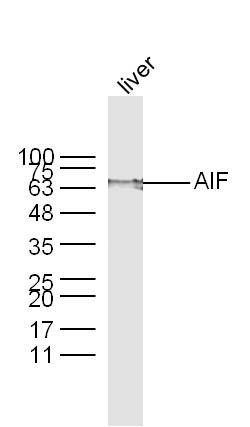 Sample:
Sample:
Liver (Mouse) Lysate at 40 ug
Primary: Anti-AIF (bs- 0037R) at 1/300 dilution
Secondary: IRDye800CW Goat Anti-Rabbit IgG at 1/20000 dilution
Predicted band size: 57 kD
Observed band size: 63 kD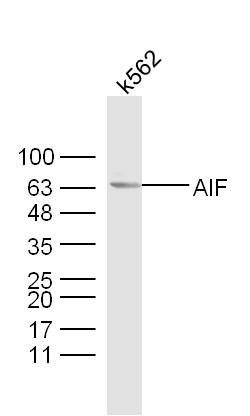 Sample: K562 Cell Lysate at 40 ug
Sample: K562 Cell Lysate at 40 ug
Primary: Anti-AIF (bs-0037R) at 1/300 dilution
Secondary: IRDye800CW Goat Anti-Rabbit IgG at 1/20000 dilution
Predicted band size: 57 kD
Observed band size: 63 kD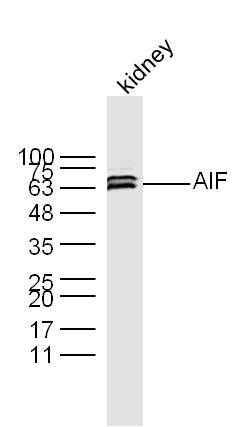 Sample:
Sample:
Kidney (Mouse) Lysate at 40 ug
Primary: Anti-AIF (bs- 0037R) at 1/300 dilution
Secondary: IRDye800CW Goat Anti-Rabbit IgG at 1/20000 dilution
Predicted band size: 57 kD
Observed band size: 63 kD